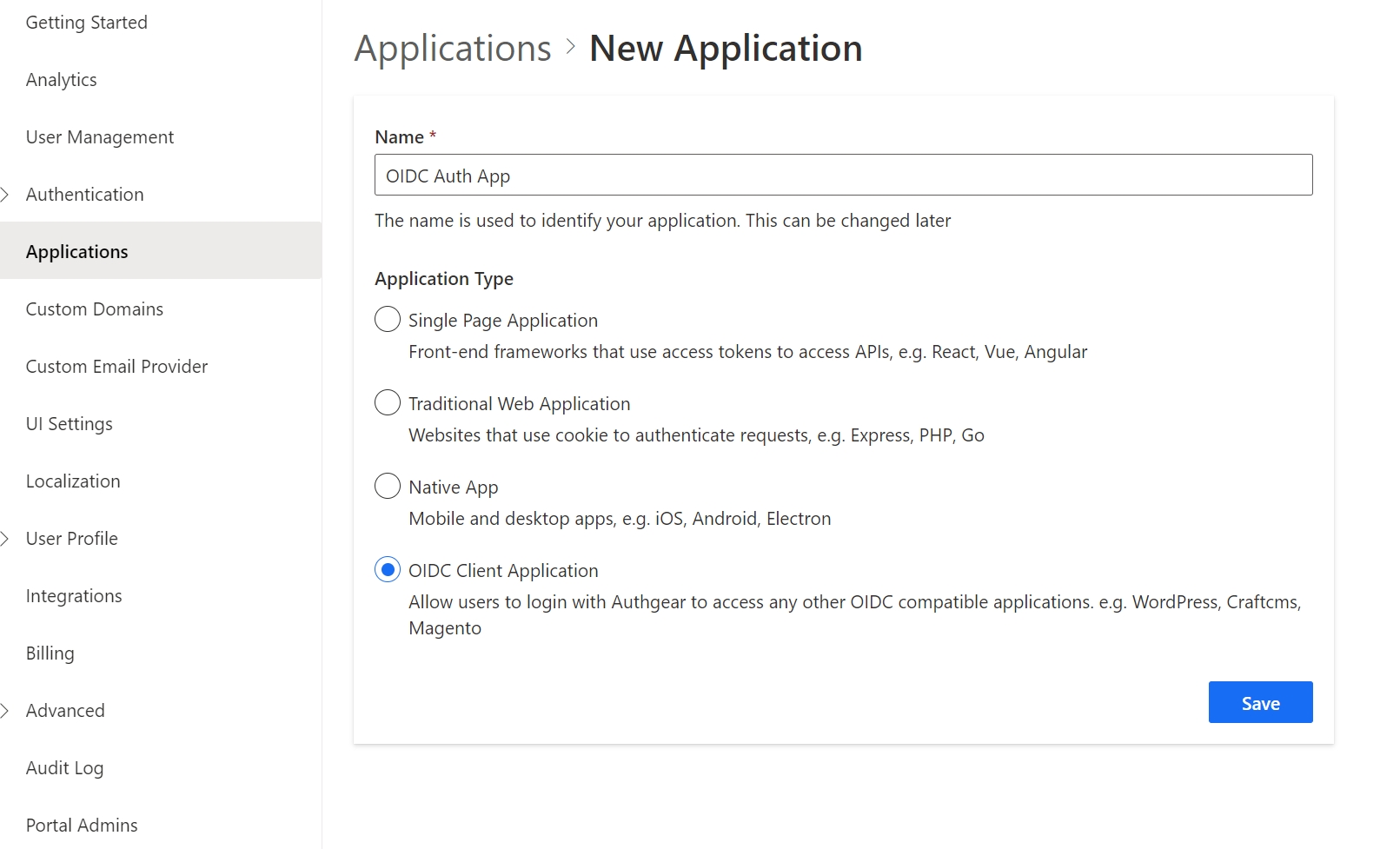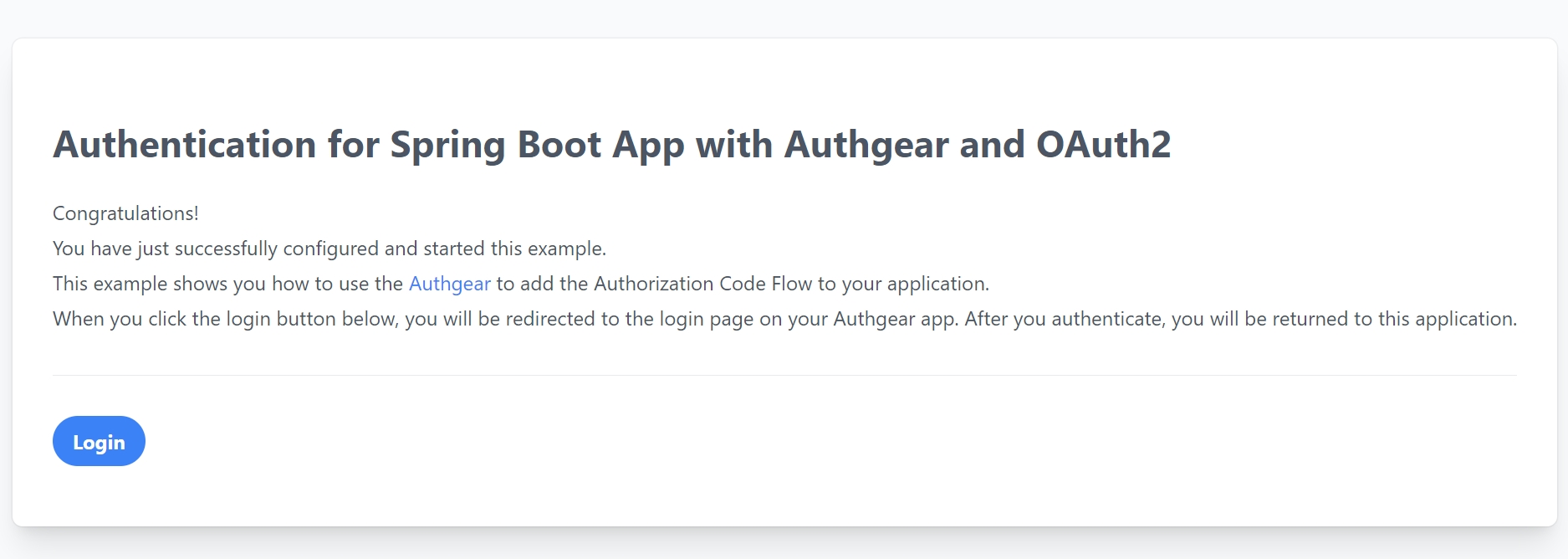Java Spring Boot
Authentication for Spring Boot App with Authgear and OAuth2
In this guide, you will learn how to add authentication to your Java Spring Boot application using OAuth2 with Authgear as the Identity Provider (IdP).
Learning objectives
You will learn the following:
How to create an app on Authgear.
How to enable Email based login.
Add sign-up and login features to Spring Boot App.
Prerequisites
Before you get started, you will need the following:
Java 17 or higher.
A free Authgear account. Sign up if you don't have one already.
Add login to your Spring Webapp
Part 1: Configure Authgear
To use Authgear services, you’ll need to have an application set up in the Authgear Dashboard. The Authgear application is where you will configure how you want authentication to work for the project you are developing.
Step 1: Configure an application
Use the interactive selector to create a new Authgear OIDC Client application or select an existing application that represents the project you want to integrate with.

Every application in Authgear is assigned an alphanumeric, unique client ID that your application code will use to call Authgear APIs through the Spring Boot OAuth 2 Client. Note down the Authgear issuer (for example, https://example-auth.authgear.cloud/), CLIENT ID, CLIENT SECRET, and OpenID endpoints from the output. You will use these values in the next step for the client app config.

Step 2: Configure Redirect URI
A Redirect URI is a URL in your application that you would like Authgear to redirect users to after they have authenticated. In our case, it will be a home page for our Spring Boot App. If not set, users will not be returned to your application after they log in.
To follow the example in this post, add the following URL as a redirect URI:
Step 3: Choose a Login method
After you create the Authgear app, you choose how users need to authenticate on the login page. From the “Authentication” tab, navigate to “Login Methods”, you can choose a login method from various options including by email, mobile, or social, just using a username or the custom method you specify. For this demo, we choose the Email+Passwordless approach where our users are asked to register an account and log in by using their emails. They will receive a One-time password (OTP) to their emails and verify the code to use the app.

Part 2: Configure Spring Boot application
Step 1: Add Spring dependencies
To create a new Spring Boot application you use the Spring Initializr. Then you add dependencies to pom.xml file such as spring-boot-starter-oauth2-client starter provides all the Spring Security dependencies needed to add authentication to your web application and Thymeleaf is used just to build a single page UI.
Step 2: Configure OIDC authentication with Authgear
Spring Security makes it easy to configure your application for authentication with OIDC providers such as Authgear. We need to add the client credentials to the application.properties file with your Auhgear provider configuration. You can use the sample below and replace properties with the values from your Authgear app:
Step 3: Add login to your application
To enable user login with Authgear, create a class that will provide an instance of SecurityFilterChain, add the @EnableMethodSecurity annotation, and override the necessary method:
Step 4: Add the front page
We create a simple home.html page using Thymeleaf templates. When a user opens the page running on http://localhost:8080/, we show the page with buttons for login or logout:

Step 5: Add controller
Next, we create a controller class to handle the incoming request. This controller renders the home.html page. When the user authenticates, the application retrieves the user's profile information attributes to render the page.
Step 6: Run the Application
To run the application, you can execute the mvn spring-boot:run goal. Or run from your editor the main ExampleApplication.java file. The sample application will be available at http://localhost:8080/.

Click on the Login button to be redirected to the Authgear login page.

You can also customize the login page UI view from the Authgear Portal. After you sign up, you will receive an OTP code in your email to verify your identity.

And log into your new account, you will be redirected back to the home page:

You have successfully configured a Spring Boot application to use Authgear for authentication. Now users can sign up for a new account, log in, and log out. The full source code of the examples can be found on GitHub.
Next steps
There is so much more you can do with Authgear. Explore other means of login methods such as using Magic links in an email, social logins, or WhatsApp OTP. For the current application, you can also add more users from the Authgear portal.
Last updated
Was this helpful?